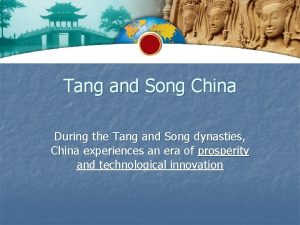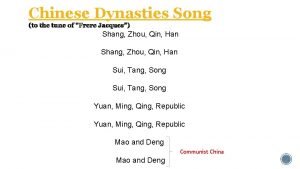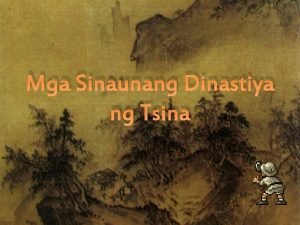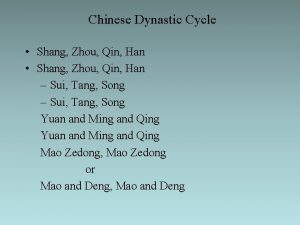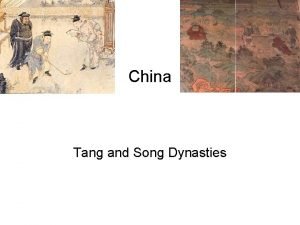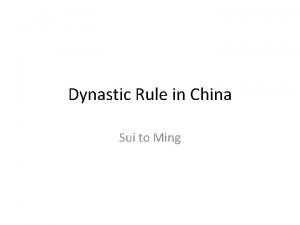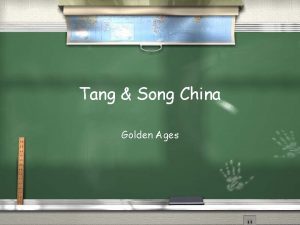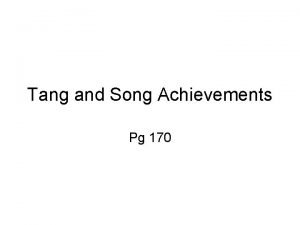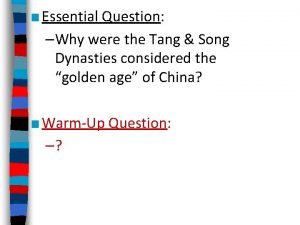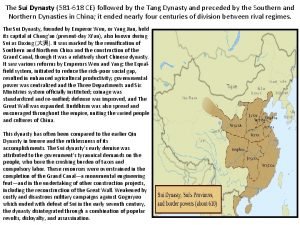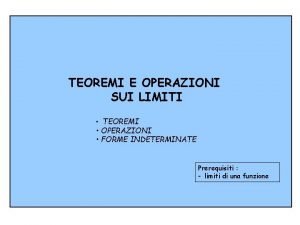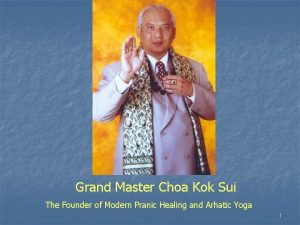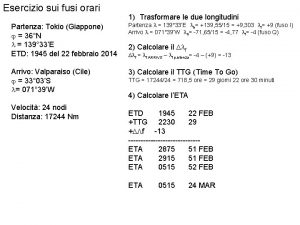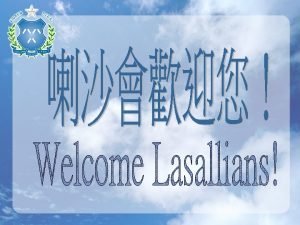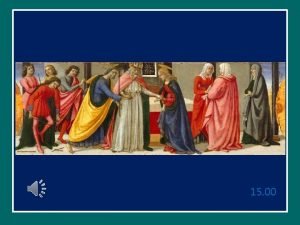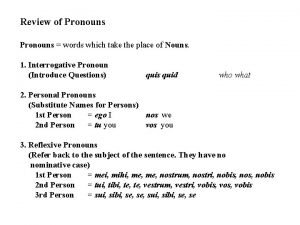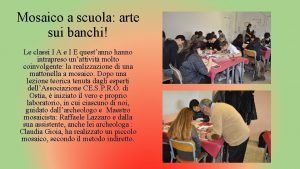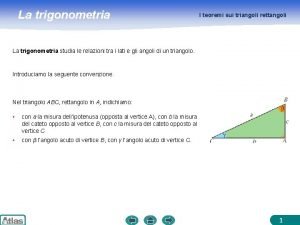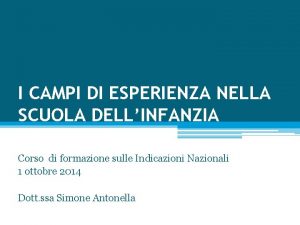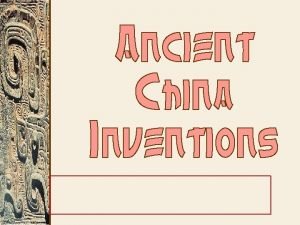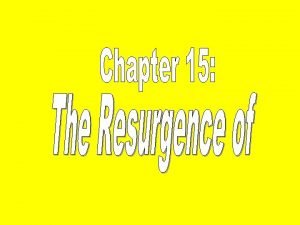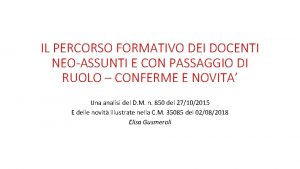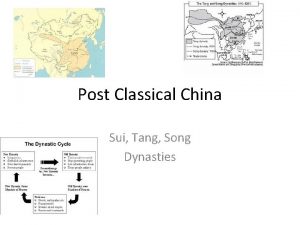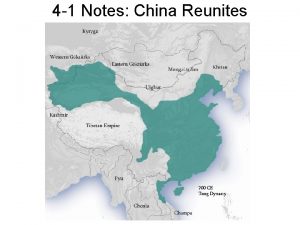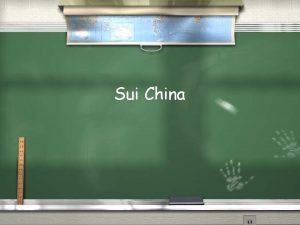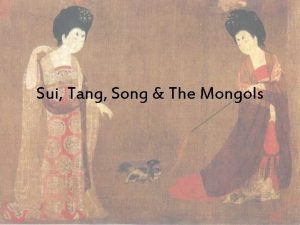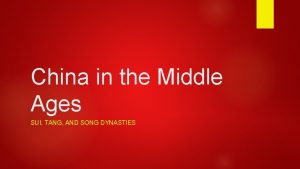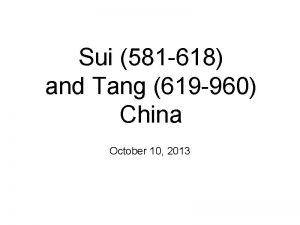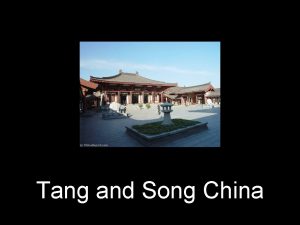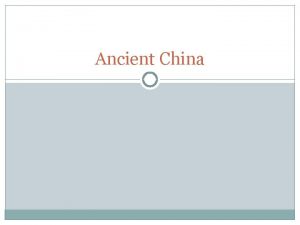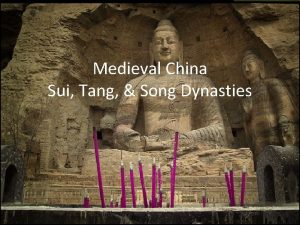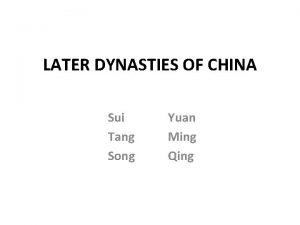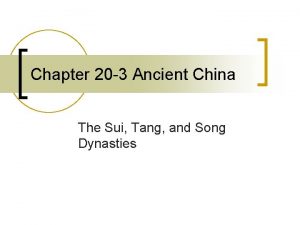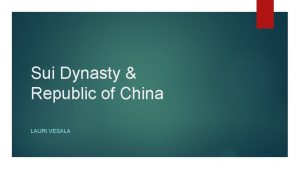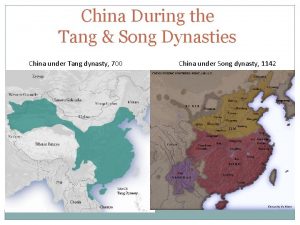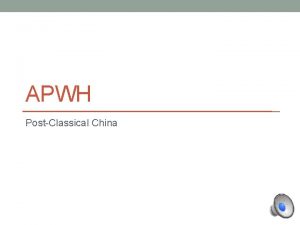China Reunited Sui and Tang n n n





























































- Slides: 61

China Reunited: Sui and Tang n n n Twitchett, Denis & Fairbank, John K. , The Cambridge History of China (v 3). Sui and T’ang. 589 -906; Ch 5: Kao-tsung (reign 649 -83) and the empress Wu: the inheritor and the usurper; Ch 6: The reigns of the empress Wu, Chung-tsung and Jui-tsung (684 -712). n Also available in Chinese translation Tung, Jowen R. , Fables for Patriarchs: Gender Politics in Tang Discourse, 2000, Ch. 2, “The Fate of Imperial Princesses”. Barfield, Thomas, The Perilous Frontier, Ch 4 pp 131 -163. 1

China Reunited n n n Introduction The Rise of Yang Jian (founder of the Sui dynasty) The Reunification of China under the Sui The Sui empire: Governance n Influence of Empress Wenxian The Reign of Sui Yangdi The end of the Sui 2

China Reunited (2) n n The Tang Dynasty n Succession Problems n Taizong n Gaozong n Usurpation of Empress Wu and the Zhou Dynasty n The Reign of Xuanzong n Expensive support of Imperial Family n The Rebellion of An Lushan n Tang after An Lushan Reference: Women of the Tang 2021/2/27 3

Introduction n By the time the Sui conquered all of China in 589, China had been fragmented for almost 400 years (not including the 51 years of the W. Jin rule when they were never able to centralize power). Wei-Jin dynasties: Years AD 200 North China Cao-Wei (220 -265) 300 Shu-Han (221 -263) Western Jin 晋(265 -316) Fragmentation of power in Northern China: the Sixteen Kingdoms; reunited by Northern Wei, c. 439 South China Wu (222 -280) Eastern Jin (317 -420) 4

Introduction (2) Years AD 400 North China Northern Wei (386 -534) 5 0 0 South China Liu-Song (420 -479) Southern Qi (479 -502) Southern Liang (502 -557) ! Eastern Wei (534 -550) Western Wei (535 -556) Chen (557 -589) ! ! ! Northern Qi (550 -577) Northern Zhou (557! 581) ! ! !______ _ Sui (581 -618) ! ! ! 5

Introduction (3) n n n During the long reign of the Northern Wei (146 years) in northern China, there were three different dynasties ruling in southern China. The Northern Wei finally ended by external forces that placed Tuoba puppets on the throne before deposing them and setting up their own dynasties, the Northern Qi and the Northern Zhou. However, these also did not last long : n Northern Qi (27 years) due to succession problems. n Northern Zhou (21 years) due to the emperor wanting to exterminate the family of his empress forcing her father to rise up against him and usurp the throne. 2021/2/27 6

The Rise of Yang Jian n n The family of the Empress: n Had served both the Northern Wei and the Western Wei. n Helped to found the Northern Zhou. n Was connected through marriage to all these royal houses. Her father, Yang Jian 楊堅 (r. 581 -604), had served the Northern Zhou empire and was rewarded by having his daughter married to the heir-apparent in 573. When Yang’s son-in-law, succeeded as emperor Xuandi (578 -579), he wanted to name his 5 th consort Empress but to do so he had to eliminate Yang’s daughter and exterminate her entire clan. When Xuandi died, Yang first became regent, then 7 eliminated the senior princes, and in 581 proclaimed

The Reunification of China under the Sui n Yang Jian (Sui Wendi) spent the first years of his reign: n Consolidating his rule over a Northern China that had been devastated by war. n Great numbers of people had fled and millions more had died. n Large areas were devastated and depopulated and had fallen out of cultivation. n Much of the north had become self-sufficient farming units and society tended to cluster in small local units dominated by one or more large clans. n For 6 -7 years he was preoccupied by the threat of the Eastern Turks. ; after he had been victorious over them, he easily conquered the Later Liang, in modern Hubei province in 587. 8 n He then turned to the conquest of the south.

The Reunification of China under the Sui (2) n n Southern China, was first ruled by the Eastern Jin 晋 (317 -420: 13 years). n Due to constant court intrigue, coups, and usurpations, it was ruled successively by short-lived (Southern) dynasties: n The Liu Song (420 -479) – 59 years n Southern Qi (479 -502) – 23 years n Southern Liang (502 -557) – 55 years n Chen (557 -589) – 32 years Ruling from present day Nanjing all these dynasties were dominated by a small group of powerful aristocratic families and by their generals. n Its great families, mostly émigrés had fled from the north and considered themselves to be the pure heirs of Han culture. 9

The Reunification of China under the Sui (3) The major achievement of the Southern dynasties was the colonization of the area south of the Yangzi and the pacification and assimilation of its aboriginal population. n Their land had become more fertile and productive than the north as they had better climate and there had been power struggles rather than battles so the land had not been devastated. In 588, Yang sent a letter to the Chen ruler saying that the Sui had a heaven-imposed obligation to take over Chen territory. n He issued an edict accusing the Chen ruler of bad faith, wastefulness, oppression of the people and other crimes. n He pointed out the unnatural occurrences which gave 10 clear signs of the withdrawal of heaven’s favor. n n

The Reunification of China under the Sui (4) n n The Chen ruler was captured in 589 and was made to write to aboriginal tribal leaders saying that the Chen had ended and they should give allegiance to the Sui. The capital of the southern dynasties for 282 years was destroyed. Ranking Chen nobles and their prized possessions were taken to the Sui capital and presented to the Sui ancestors. n The Chen nobles and elite were forgiven for their crimes and the princes given land in the border areas; some were taken into service by the Sui. The reunification of China was complete and the south became an important source of wealth and reserves. 11

The Sui Empire: Governance n Administratively there were difficulties between the north and the south: n Regional and racial differences n The north: n Devastation of land due to wars n Inter-racial violence and hatred n Yangzi Valley and further south: n Distinctive civilization based on Han heritage n Population differences: n North – cultural and racial mix – successive waves of conquerors and those who intermarried with the Chinese. n South was 16% of the total population and 12 concentrated in the major centers along the

The Sui Empire: Governance – Influence of Empress Wenxian n n Empress Wenxian (b. 544 -602), wife of the founding emperor, was from a powerful and long sinicized Xiongnu clan. n Her clan had inter-married with the great families of Northern Wei for centuries. n She was a literate and cultivated woman with strong political instincts. The Emperor and the Empress were very close and the palace attendants called them “the two sage-emperors”. n She would ride with him in the carriage to the audience hall and wait in side room. n Her eunuchs would be inside the hall observing and reporting. 13 13

The Sui Empire: Governance – Influence of Empress Wenxian (2) n n n She kept her family out of positions of great power. n When a relative of hers committed a crime that required the death penalty she said that the emperor should not consider personal factors and the man was executed. She was a fervent Buddhist and made sure the imperial princes were taught Buddhism; however, when one wanted to become a Buddhist priest, he was denied permission. She and the emperor were very close and the Emperor had promised her that he would not have any children by any other wife. n When she was about 50 years of age, her husband was attracted by the charms of the grand-daughter of 14

The Sui Empire: Governance – Influence of Empress Wenxian (3) n n n As she became older, she became more jealous and whenever the concubine of a prince or of a minister became pregnant she would urge that the husband be dismissed. She became suspicious when the principal consort of her eldest son, the heir, suddenly died and found that the heir was infatuated with his favorite concubine. Yang Guang (r. 605 -618), the second son, saw an opportunity to plot his brother’s downfall and become the heir. n He and his supporters made up evidence to mislead the suspicious emperor and empress and the heir was deposed and Yang Guang was named heir. 15

The Reign of Sui Yangdi n n n After the death of Empress Wenxian, the emperor gradually handed over the management of state affairs to Yang Guang. n In 603, the emperor was persuaded by alleged evidence of black magic to degrade his fourth son. n The evidence also cast suspicion on the fifth son. The emperor became ill in 604 and Yang Guang and his supporters may have hastened his end. Yang Guang became emperor in 605 and is known as Yangdi (r. 604 -17). n Eight days later, the 5 th son rebelled but was crushed and died in prison. n He restored Confucian education and the Civil Examination System recruiting Chinese officials into 16 the Government.

The Reign of Sui Yangdi (2) n Yang Guang was very ambitious and wanted to extend the empire into the old Han territories of the north-west and into northern Korea. n He had large public construction projects. 17

The Reign of Sui Yangdi (3) n He only reigned for about 26 years as: n He lost the support of nomads when his invasions into Korea failed and there were over 2 million casualties. n There were invasions into China from Turkic nomads. n The cost and loss of life involved in public works -- the rebuilding of the Great Wall and the construction of canals, caused widespread suffering and discontent. He lost the support of Chinese officials when the peasants felt that they could no longer support all these expenses. n He was assassinated by his own ministers and many 2021/2/27 rebel forces fought and the victor was the Duke of Tang 18 n

The Tang Dynasty (618 – 907) n n n Li Yuan 李淵, the Duke of Tang, was a favorite of the Sui founding emperor, Wendi. n His mother and Empress Wenxian were sisters; he and Sui Yangdi were first cousins. n When Sui began to fall apart, Li Yuan, led one of the many groups of rebels. In 619, his armies took the capital and he founded a new dynasty that lasted 300 years. n The dynasty was briefly by the Second Zhou Dynasty (690 -705) when Empress Wu Zetian seized the throne, becoming the first and only female emperor. The Tang built its great empire based on the solid foundations left by Sui who had unified the country. 19

The Tang Dynasty (2) n The Tang Dynasty early rulers had many victorious military campaigns against their nomadic neighbors and expandied the territory under rule. n The Chinese Empire was always larger when it was under non-Han rule as they were more expansionoriented and their territories would also include their homelands. 20

Succession Problems: Taizong n n n Li Shimin 李世民, the 2 nd son, was not the heir to the throne. n He felt that he had made the greatest contributions in helping to conquer the empire should be the heir. n He accused his brothers of having had illicit relations with members of the imperial harem. n When the brothers learned of this, they went to speak to the emperor but when they came to the entrance to the palace, they were attacked and killed by Li Shimin’s waiting men. Li Shimin then marched, fully armed, to see his father who was intimidated and named him the heir. As heir, he forced his father into retirement and Li Shimin became the second emperor, Taizong (r. 626 -49). 21

Succession Problems: Taizong (2) n Taizong named the eldest son of the empress as his heir. He executed those close to the heir so that they would not be influential; the heir became alarmed and plotted his father. n When the plot was revealed, the emperor degraded the heir to the status of a commoner and imprisoned him. Taizong’s favorite son was his 4 th son, Li Tai, who hoped to be made heir. The ministers recommended another son but the Emperor was not happy with the choice and wanted to name a son whose mother had been the daughter of Sui Yangdi. They finally decided on Li Zhi 李治, the ninth son, and a high powered group was appointed as his tutors. 22 n n

Succession Problems: Gaozong n n n Gaozong was in poor health relied on his second empress, Wu Zetian for help. In 657 he was forced to hold court only on alternate days. n Three years later, he suffered a serious stroke which left him partially paralyzed and with poor eyesight. The Empress began administering the empire during his sicknesses and was ruler of the empire in fact though not in name – de-facto ruler. n Since there was no precedent for the direct control of the government by an empress, during the Emperor’s lifetime, there was continued opposition from officials to Wu Zhao. 23

Succession Problems: Gaozong (2) Wu looked for the allegiance from groups whose support would give her prestige and influence–the literati and the Buddhist and Taoist clergy. The heir, Li Hung, was a favorite of the emperor and of the court but had frequently taken the side of the emperor against his mother, Empress Wu. n Wu was suspected of poisoning him (671) as they had just had a public dispute over Consort Xiao’s two daughters who had been imprisoned in the palace for 20 years and were not married. Wu’s second son, Li Xian, was named the heir. n n n 24

Succession Problems: Gaozong (3) n Wu then began to consolidate her power, removing members Wu then began to consolidate of the imperial family that might be a threat to her. n The emperor’s second son was banished on trumped up charges. n She wanted to replace her second son, the heir, with her third son who was only 14. n She had a sorcerer say that the heir would not be a good emperor and rumored that he was not really her son but that of her elder sister. n She made a formal complaint that he was intimate with some of his household slaves. n On investigation, several hundred suits of armor were discovered and he was suspected of planning a coup. 25

Succession Problems: Gaozong (4) The emperor did not completely believe in the charges and wanted to pardon him but Wu insisted that he be demoted to commoner status and imprisoned. n The second son was later banished and ordered to commit suicide. Wu’s third son, the young boy was then named heir in 680. Gaozong died (683) naming Wu as regent. Wu’s third son, Zhongzong 中宗 (r. Jan 3 -Feb 26, 684; Feb. 23, 705 -July 3, 710) was on the throne for two months before his mother deposed him in favor of his younger brother. n Zhongzong’s chances of succession was remote so 26 n n

Succession Problems: Gaozong (5) As Emperor, his first act was to name his father-inlaw, the Chief Minister; this was opposed by officials who had been appointed by the previous Emperor. n Zhongzong then said that he could have given his father-in-law the entire empire; ED Wu decided to take it literally. n She summoned her son to court, charged him with treason and deposed him – the guards dragged him from the throne – he and his pregnant wife, Empress Wei, were banished. The next day, Zhongzong was replaced by Wu’s fourth son, Ruizong 睿宗 (r. 684 -690; 710 -712). As regent, Wu presided openly at all the functions of the court, not bothering to hang the curtain. n Ministers began to warn her that she was behaving 27 n n n

Succession Problems: Gaozong (6) In 688, some of the princes of the imperial clan revolted and Empress Wu purged the imperial family. n Rebellions arose as many opposed her assumptions of power. n She was able to suppress the rebellions. In 690, at the age of 65, she made Ruizong abdicate and proclaimed herself emperor of a new dynasty, the Zhou dynasty (690 -705) which lasted for 15 years. n Ruizong and his family were kept in isolation in the palace with the title Emperor Expectant. n n 28

Usurpation of Empress Wu and the Zhao Dynasty n n n Wu Zetian -- Wu Zhao -- (b. 625; r. 690 -705) -- had been a low ranking concubine of Taizong, entering the palace when she was in her early teens. n Her father was a supporter of the founder of the dynasty and her mother was from the Sui imperial Yang family. Gaozong had been 8 when his mother died and continued to live in the Inner Palaces and might have been intimate with Wu Zetian. After Taizong’s death, his minor wives were sent into the temple; on the anniversary of Taizong’s death, Gaozong visited the temple and saw her again and revised his interest in her. 29

Usurpation of Empress Wu and the Zhao Dynasty (2) At that time, Gaozong’s principal consort, Empress Wang was childless and her husband’s favorite was a consort named Xiao. n Empress Wang decided to bring Wu into the harem as a rival to Consort Xiao. n The Han would view it as incest – since Wu had been a consort to Gaozong’s father – but the Tang dynasty was of mixed origins and might have accepted the practice as levirate – marrying the widow to the son or brother of the deceased husband. n After Wu had given birth to two sons, Empress Wang realized that Wu was a more dangerous rival than Xiao and began a campaign of slander. 30 2021/2/27 n

Usurpation of Empress Wu and the Zhao Dynasty (2) n n Wu allied herself with the other women who hated the Empress and bribed them to spy on the Empress and Consort Xiao. Wu wanted to be named empress but Gaozong had no intention of deposing his empress. n Wu was said to have created the impression that the Empress had suffocated Wu Zhao’s new-born baby girl. The Emperor became furious and decided to demote Empress Wang and elevate Wu as empress. Many officials opposed Wu’s promotion to Empress but Gaozong finally won support and accused Empress Wang and Consort Xiao of plotting to poison him. 31

Usurpation of Empress Wu and the Zhao Dynasty (3) n n Wu was installed empress (655) after Wang and Xiao were demoted to commoner status. n Wu then murdered Wang and Xiao cutting off their arms and leaving them to die in a wine vat. n She had the officials who opposed her promotion transferred and those who supported her promoted– she removed all the chief ministers who had served the previous emperor, Taizong. Since Gaozong was often ill and Wu had to assist him in court, she tried to gain support from the common people and the bureaucracy by proposing a 12 point program (674). n The main provisions were: 32

Usurpation of Empress Wu and the Zhao Dynasty (4) n n n n n To encourage agriculture and sericulture and reduce taxes and labour services. To grant remission of taxes to the metropolitan districts. To cease military operations; to transform the empire by the virtue of the Way. Palace buildings would not indulge in extravagantly fine workmanship. To reduce wasteful employment of corvée labour. To increase the opportunities for the expression of opinions to the throne. To suppress slander. Everyone, from the princes and dukes down, would study the Daode Jing 道德经. Even when the father was still alive, mourning was to be observed for the full three-year period for the mother. 33

Usurpation of Empress Wu and the Zhao Dynasty (5) n All honorific officials who had received their documents of appointment before 674 could retain their titles, however earned. n Salaries of metropolitan officials of the 8 th rank and above would be increased. n Long-serving officials, whose talent was greater than their rank, would be promoted. n In 690, she made Ruizong abdicate and she proclaimed herself emperor of a new dynasty, the Zhou dynasty (690 -705). n Her nephew began to see himself as her successor and put up a petition to make one of them the heir even though Ruizong, had the title, Emperor Expectant. n Emperor Wu seemed surprised and asked the opinion of 34 2021/2/27

Usurpation of Empress Wu and the Zhao Dynasty (6) In 962, one of her officials convinced her of the danger of giving her relatives too much power and she took away all of their political functions. n At the same time, she did not want people to think that Ruizong was to succeed and punished those who got too close to him. n Emperor Wu was torn between the claims of her own clan and those of her sons as successors. n Emperor Wu was recognized as a capable and attentive ruler even by traditional historians who despised her, and her ability at selecting capable men to serve as officials was admired throughout the rest of Tang Dynasty as well as subsequent dynasties. 35 2021/2/27 n

Usurpation of Empress Wu and the Zhao Dynasty (7) During Wu’s reign she oversaw: n The greatest expansion of T'ang military power; n The expansion of the civil service examination. n The emphasis on both Daoism and Buddhism. n The development of agriculture -- construction of irrigation schemes; compilation of text books on agriculture; local officials were to bring more land under cultivation. n The reduction of taxes and stopped the imposition of corvee upon the peasant population. n The allowance of peasant farmers to retain more of their produce so that they were able to improve their 36 2021/2/27 lot. n

n Usurpation of Empress Wu and the Zhao Dynasty (8) Wu was against the Confucianism belief of the subordination of women to men. n She improved the position of women in society. n She employed scholars to write biographies of famous women to show that women were every bit as capable of men. n She promoted equal opportunity for women. n She allowed women to sit for the highest level of the civil service examinations, jin shi 进士 if they passed the poetry examinations. 2021/2/27 37

n n n Usurpation of Empress Wu and the Zhao Dynasty (7) In 698, Zhongzong, and his empress, Wei, were summoned from their exile on the advice of officials. n Zhongzong was given the title of heir-apparent and his younger brother, Ruizong, was demoted. In 705, ED Wu was 80 years old and ill and was unable to prevent Zhongzong and his allies from taking power but she retained the title of "emperor" until her death later in the year Zhongzong’s reign began with three factions competing for power – favored ministers, the imperial family, and the relatives of his wife, Empress Wei. 2021/2/27 38

The Reign of Zhongzong n n n In 698, Zhongzong, and his empress, Wei, were summoned from their exile as ED Wu was growing old had decided that the throne should be returned to the Li family. In 705, ED Wu was 80 years old and ill and she was unable to prevent Zhongzong and his allies from taking power. She abdicated and Zhongzong’s reign began with three factions competing for power – favored ministers, the imperial family, and the relatives of his wife, Empress Wei. n The imperial family, and the relatives of Empress Wei sold official positions and merchants and landlords 39 could buy their way into officialdom instead of taking

The Reign of Ruizong n n n When Zhongzong suddenly died, Empress Wei was afraid that she and her daughter might be suspected of poisoning him. n She concealed his death until she had appointed her relatives to key military positions and named the emperor’s youngest son, a boy of 15, to succeed with herself as regent. The young emperor ruled for two weeks until Princess Taiping, daughter of Empress Wu, with the help of Ruizong’s son – the future Xuanzong 玄宗 -- dragged the young boy from his throne and had her brother, Ruizong, take up the throne. Both Empress Wei and her daughter, Princess Anle 40

The Reign of Xuanzong n n Xuanzong was the longest reigning of all the Tang monarchs; he restored the dynasty to a new peak of power after decades of corruption during the reigns of his two brothers. He tried to control his relatives from seizing power and took away the military power of his relatives by forbidding royal princes and consorts of princesses to hold commands in the guards. n They were removed from the capital so that they could not be used as figure heads for different factions. n They were given ceremonial offices with no power at court but kept near the capital. n Two of the princes must rotate and attend court every three months. 41

The Reign of Xuanzong (2) n n Xuanzong had 51 children, many of them born before he came to the throne. n The next generation was even more numerous – 94 grandsons – and there is no record of the number of children born to his 30 daughters. The support of the imperial clan became very expensive. n After some time, the adult royal children were not given individual residences but just a court yard home for themselves and their families -- they were even more centrally controlled. 42

The End of Xuanzong’s Reign and the Rebellion of An Lushan In the early 740 s, Xuanzong became infatuated with Lady Yang, the wife of his son, Li Mao. n Yang was descended from the Sui imperial clan. n She left her husband in 741 and registered as a Daoist priestess and took up residence in the palace. n In 745, Xuanzong took her into his own harem with the title of Consort of the First Rank 贵妃 after she had been formally separated and her husband had remarried. n From then on, she dominated the palace. n In the late 740’s she became a close friend of a general, An Lushan, and adopted him as her son; they remained 43 good friends. 2021/2/27 n

The End of Xuanzong’s Reign and the Rebellion of An Lushan (2) n n n An Lushan was a general who was part Turkish and part Soghdian (part of the Persian Empire). The enemies of Yang and An began to harass An and accuse him of plotting rebellion; his mansion was raided and it was said that plans for rebellion was discovered. An Lushan did not dare to attend court in person but the Emperor still had faith in his loyalty but his enemies continued to convince the emperor that he was going to rebel until An Lushan was forced to do so. n An was successful at first and took the eastern capital, Luoyang. n In 756 he proclaimed himself emperor of the new dynasty of Greater Yan. n In 756, the Xuanzong was forced to flee Chang’an. 44

The End of Xuanzong’s Reign: The Rebellion of An Lushan (3) n n n Xuanzong’s troops were resentful of Consort Yang’s brother, attacked him and killed him and members of his family. They demanded the execution of Consort Yang. n The Emperor had no choice but to order her strangled. The troops were pacified and they went on to Chengdu. Meanwhile, the heir-apparent, the future Suzong (r. 756762), organized resistance in the north. n He was in command of 2, 000 troops and was persuaded to usurp the throne and give Xuanzong the title, Retired Emperor. The rebellion continued after An’s death and was finally suppressed in 763. The Tang had a century of stability until the An Lushan rebellion in 775. 45

Tang after An Lushan n By the time the rebellion was over, China had abandoned its territories in southern Manchuria, and the entire modern Gansu had fallen to the Tibetans. The most important long-term damage was the loss of authority by the central government as the military governors 节度使 had been given powers over local administration. n The next emperor and his successors had to compromise with these powerful local forces resulting from the rebellion. In the late 9 th century, discontent led to the Huang Chao rebellion and the fragmentation of the country leading to the period known as the Five Dynasties and Kingdoms. n Some parts of northern China fell into alien rule in the 46 early 10 th century and northern China remained

Reference: Women of the Tang n n Women of the Tang was greatly influenced by the nomadic cultures. Comparison of Han and Tang handbooks show more freedom for Tang women. Women of the Tang had the characteristics of: n Princess Pinyang, daughter of founding emperor n Empress Wu; Emperor of the second Zhao Dumasty n Empress Wei, wife of Zhongzong n Princess Anle, daughter of Zhongzong and Empress Wei n Princess Taiping, daughter of Empress Wu and sister to Zhongzong As the empire began to end, its grip on women tightened. 47

Princess Pin-yang n n n Princess Pinyang (ca. 600 -623), daughter of the first Tang emperor, helped her father overthrow the Sui by organizing the “Woman’s Army”. She formed a woman’s army among the peasants. Other rebel forces in the region began to join her when they heard of her father’s successes; as she won battles, many new rebel groups were eager to fight under her banner. After each of her victories, her army would distribute food and win over the people in the captured territories. When her army grew to 70, 000 troops, the Sui army took her seriously and launched an attack on her but were defeated. When her father became emperor, she was made a 48 marshal with the same entitlements as her brothers.

Empress Wei, wife of Zhongzong n n Zhongzong’s reign began with three factions competing for power – favored ministers, the imperial family, and the relatives of his wife, Empress Wei. n The imperial family, and the relatives of Empress Wei sold official positions and merchants and landlords could buy their way into officialdom instead of taking the examination. The most powerful persons were Empress Wei and her lover, Wu Sansi, the son of Wu’s half-brother. n By being Wei’s lover, Wu Sansi survived his aunt’s downfall. n Her faction Empress Wei’s faction was made up of 49 Wu Sansi, Shanghuan Wan-er – who drafted Empress

Empress Wei (cont. ) n n During palace struggles between Empress Wei and her husband’s sister, Princess Taiping, made Zhongzong unhappy about his wife’s affairs. n Empress Wei was afraid and when the Emperor suddenly died she was suspected of having poisoned him. n The Empress concealed his death until she had appointed her relatives to key military positions and named the emperor’s youngest son, a boy of 15, to succeed with herself as regent. The young emperor ruled for two weeks until Princess Taiping, with the help of Ruizong’s son – the future Xuanzong 玄宗 -- dragged him from his throne and had 50 her brother, Ruizong, take up the throne.

Princess Anle, Daughter of Zhongzong and Empress Wei n n Princess Anle, the only surviving child of Empress Wei, was very powerful and was married to the son of Wu Sansi. She became rich from selling ordination certificates for 30, 000 cash each so that persons of any social rank could be ordained to the Buddhist clergy; for ten times that amount, a person could become an official on the staff of one of the princesses. Wu Sansi hoped to rule through his daughter-in-law and so lobbied to have Princess Anle named as heir to the throne. As no woman had ever been considered as heir, the court was upset and the ministers blocked the plan and retained the current heir, the emperor’s second son by a 51

Princess Anle (cont. ) n n n Wu Sansi tried a second time to promote Princess Anle as the heir. n The heir-apparent – Zhongzong’s only son born of a concubine -- became very uneasy and felt that he had to act and so he marched on the Wu mansion. n He killed Wu Sansi and his son, the husband of Princess Anle. The widowed Princess Anle started having an affair with another nephew of ED Wu and soon married him. After the death of Wu Sansi, Empress Wei, Anle and her new husband tried to slander Ruizong and the Taiping Princess 太平公主 but the two easily cleared themselves. 52

Princess Taiping, Daughter of Empress Wu and sister to Zhongzong n n n The only persons at court who had matched Wu Sansi’s prestige were Ruizong and his sister, the Taiping princess. n Wu Sansi rewarded them with money to keep them out of politics; he made it possible for Princess Taiping and 6 other princesses to have the same benefits as other royal princes. n After Wu’s death, the Wei faction tried to eliminate her and so she began to build support for her brother, Ruizong delegated real power to her when she helped place him on the throne. Xuanzong, Ruizong’s son, was a very popular heir 53

Princess Taiping (cont. ) n n Even in exile, her influence was still strong and the heir, knowing that she blamed him for her banishment asked that she be allowed to return. n When she returned to the capital she immediately replaced five of the top seven officials with her own men. Ruizong was upset that he could not control the situation and in 712, he decided to abdicate in favor of the heir. Taiping convinced him to retain the title “Retired Emperor” and control high appointments and capital punishments. When Xuanzong (r. 712 -756) became emperor, she became uneasy and tried an armed coup but the plan was leaked and Xuanzong seized her supporters and had them beheaded. 54 n She escaped to a monastery but was forced to

Consorts of Xuanzong n n Xuanzong’s empress, Wang, was a member of the prominent Wang clan of Taiyuan. n Her twin brother was married to Ruizong’s 7 th daughter and had helped to overthrew Princess Taiping. n Xuanzong kept both him and his father from positions of power but allowed them to become wealthy. The Empress had no children and since it was important to settle the question of succession Xuanzong’s second son was named heir in 715. n He was probably chosen as his mother was Xuanzong’s favorite concubine. 55

Consorts of Xuanzong (2) n Xuanzong secretly discussed, with his minister, the removal of the Empress as she was childlessness but this was leaked to her. n The Empress was now fearful of her position and was desperate to produce a son to ensure her position at court. n Her brother arranged for a monk to perform ceremonies for her to ensure that she had a child. n When this was discovered in 724, the Empress was accused of witchcraft and degraded to commoner status. n Her her brother was exiled, divorced from his royal wife, and ordered to commit suicide. n The deposed empress was allowed to live in separate quarters in the palace where she died a few months 56 later.

Consorts of Xuanzong (3) n n n Soon after Xuanzong came to the throne, he became enamored of his concubine Lady Wu. – daughter of a close relative of the ED Wu. When the position of Empress became vacant, Xuanzong wished to name her empress but this was opposed by the bureaucracy as: n her family, Wu, had been enemies of the Tang; n she was not the mother of the heir and did not yet have sons – she later gave birth to a son, Prince Mao. The emperor did not make her empress during her lifetime although she was treated as his most important consort and her family members were given honors and promotion appropriate to the family of an empress. 57

Consorts of Xuanzong (4) n Consort Wu wanted to get rid of the heir and have her son named heir-apparent. n She had her son-in-law accuse the heir and his fellow princes, together with the heir’s brother-in-law (consort of Xuanzong’s 3 rd daughter) of plotting rebellion. n The emperor reduced the princes to commoner status and ordered them to commit suicide; many relatives of the mothers and wives of the princes were sent into banishment. n The position of heir-apparent was now available but Consort Wu died and her son, Li Mao, no longer had the support of his mother. 58

Consorts of Xuanzong: Yang Guifei n n After the death of Consort Wu, Xuanzong did not have a favorite until the early 740’s when he became infatuated with the wife of his son, Li Mao. n She was descended from the Sui imperial clan. n She left her husband in 741 and registered as a Daoist priestess and took up residence in the palace. n In 745, Xuanzong took her into his own harem with the title of Consort of the First Rank 贵妃 after she had been formally separated and her husband had remarried. From then on, she dominated the palace. 59

Consorts of Xuanzong: Yang Guifei (cont. ) n n n Lady Yang was very talented and shared similar interests as the emperor in music and dance and was a skilled performer. n Several members of her family were given noble titles and high positions at court. In the late 740’s she became a close friend of a general, An Lushan, and adopted him as her son; they remained good friends. n An Lushan a general who was part Turkish part Soghdian (part of the Persian Empire). The enemies of Yang and An began to harass An and accuse him of plotting rebellion; his mansion was raided and it was said that plans for rebellion was discovered. 60

Next Reading n The Turks, China and the Five Dynasties n Wang Gungwu, The Structure of Power in Northern China during the Five Dynasties, Stanford, Calif. : Stanford University Press, 1967. 61
 How was china reunited under the sui dynasty?
How was china reunited under the sui dynasty? Tang and song china
Tang and song china How did the sui and tang dynasties reunite china
How did the sui and tang dynasties reunite china Sui dynasty achievements
Sui dynasty achievements Where was the sui dynasty located
Where was the sui dynasty located Sui tang and song dynasties
Sui tang and song dynasties Chinese dynasty song frere jacques
Chinese dynasty song frere jacques Hsia dinastiya
Hsia dinastiya Dynastic cycle
Dynastic cycle Sui tang song
Sui tang song Fsebo
Fsebo Sui tang song
Sui tang song Ming and qing dynasty venn diagram
Ming and qing dynasty venn diagram Chapter 12 section 1 tang and song china
Chapter 12 section 1 tang and song china How did the sui dynasty affect daily life in china
How did the sui dynasty affect daily life in china The fellowship reunited
The fellowship reunited Buddhism and chinese culture
Buddhism and chinese culture Biggs tang
Biggs tang Golden age of tang and song dynasties
Golden age of tang and song dynasties Song dynasty achievements
Song dynasty achievements The tang and song eras were a golden age of
The tang and song eras were a golden age of The tang and song eras were a golden age of
The tang and song eras were a golden age of Achievements of the tang and song dynasties
Achievements of the tang and song dynasties Ce sui
Ce sui Diritti umani collegamento con italiano
Diritti umani collegamento con italiano Teorema sui limiti
Teorema sui limiti Forme indeterminate
Forme indeterminate 618 ce
618 ce Prove meccaniche sui metalli
Prove meccaniche sui metalli Foto di pioggia sui vetri
Foto di pioggia sui vetri Mappa concettuale frazioni algebriche
Mappa concettuale frazioni algebriche La marcia dei diritti dei bambini con testo
La marcia dei diritti dei bambini con testo Compito di realtà sui romani
Compito di realtà sui romani Giovanni verga temi
Giovanni verga temi Master choa kok sui
Master choa kok sui Esponenziali zanichelli
Esponenziali zanichelli I carboidrati mappa concettuale
I carboidrati mappa concettuale Messi sui
Messi sui I diritti dei bambini delle fiabe
I diritti dei bambini delle fiabe Testo espositivo promessi sposi
Testo espositivo promessi sposi Le colpe dei padri ricadono sui figli tragedia greca
Le colpe dei padri ricadono sui figli tragedia greca Triplo prodotto vettoriale
Triplo prodotto vettoriale Trattato sui principi della conoscenza umana
Trattato sui principi della conoscenza umana Calcolo fusi orari esercizi
Calcolo fusi orari esercizi Poesie siciliane antiche
Poesie siciliane antiche Chan sui ki (la salle) primary school
Chan sui ki (la salle) primary school Osculetur me osculo oris sui
Osculetur me osculo oris sui Sui sibi se se
Sui sibi se se Arte sui banchi
Arte sui banchi Condizionamento classico subliminale
Condizionamento classico subliminale Teoremi triangoli rettangoli
Teoremi triangoli rettangoli I campi d'esperienza
I campi d'esperienza Qin dynasty inventions
Qin dynasty inventions Uccello di fuoco alda merini
Uccello di fuoco alda merini Buffervoorraad
Buffervoorraad Sui kingdom
Sui kingdom Schema sui lipidi
Schema sui lipidi Sui iuris
Sui iuris Civiltà cinese ricerca 4 elementare
Civiltà cinese ricerca 4 elementare Je suis tu es nous sommes vous etes
Je suis tu es nous sommes vous etes Je suis tu est il est
Je suis tu est il est Esempi di relazioni sui laboratori formativi
Esempi di relazioni sui laboratori formativi

